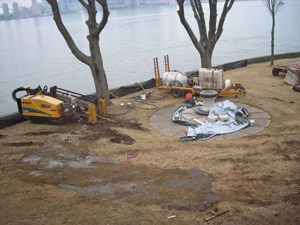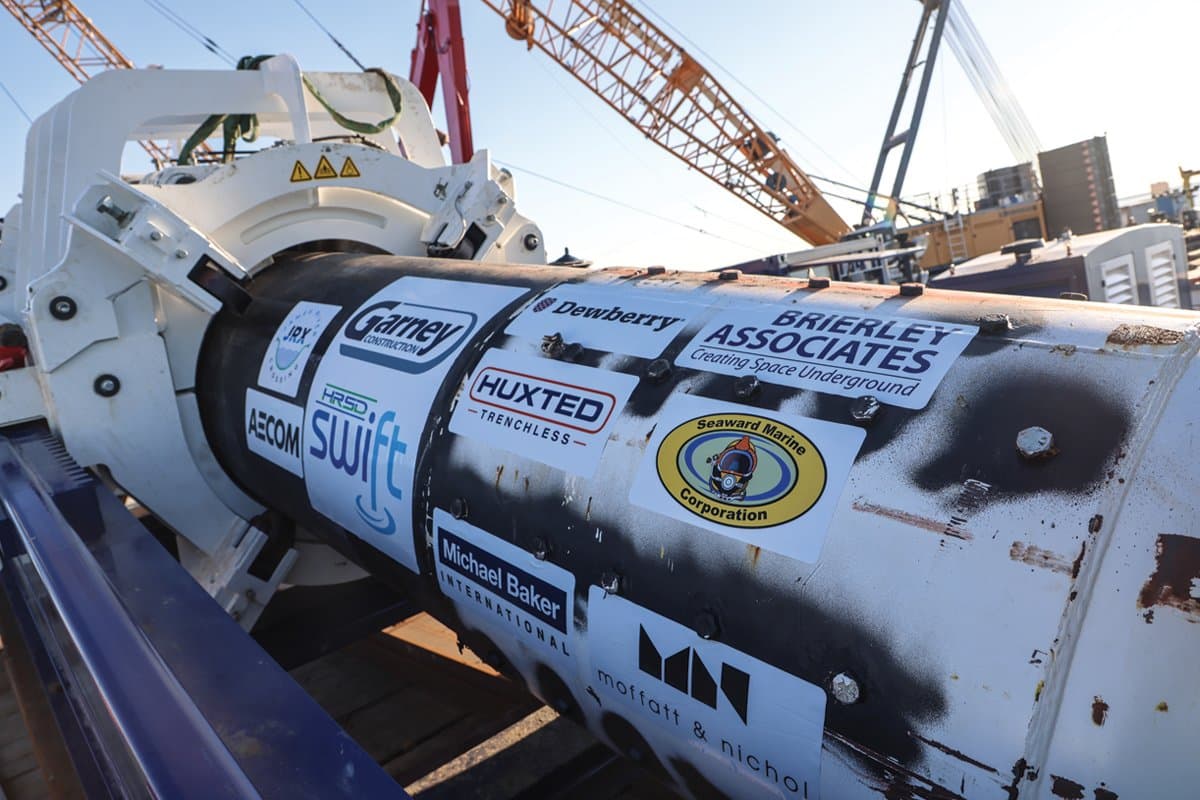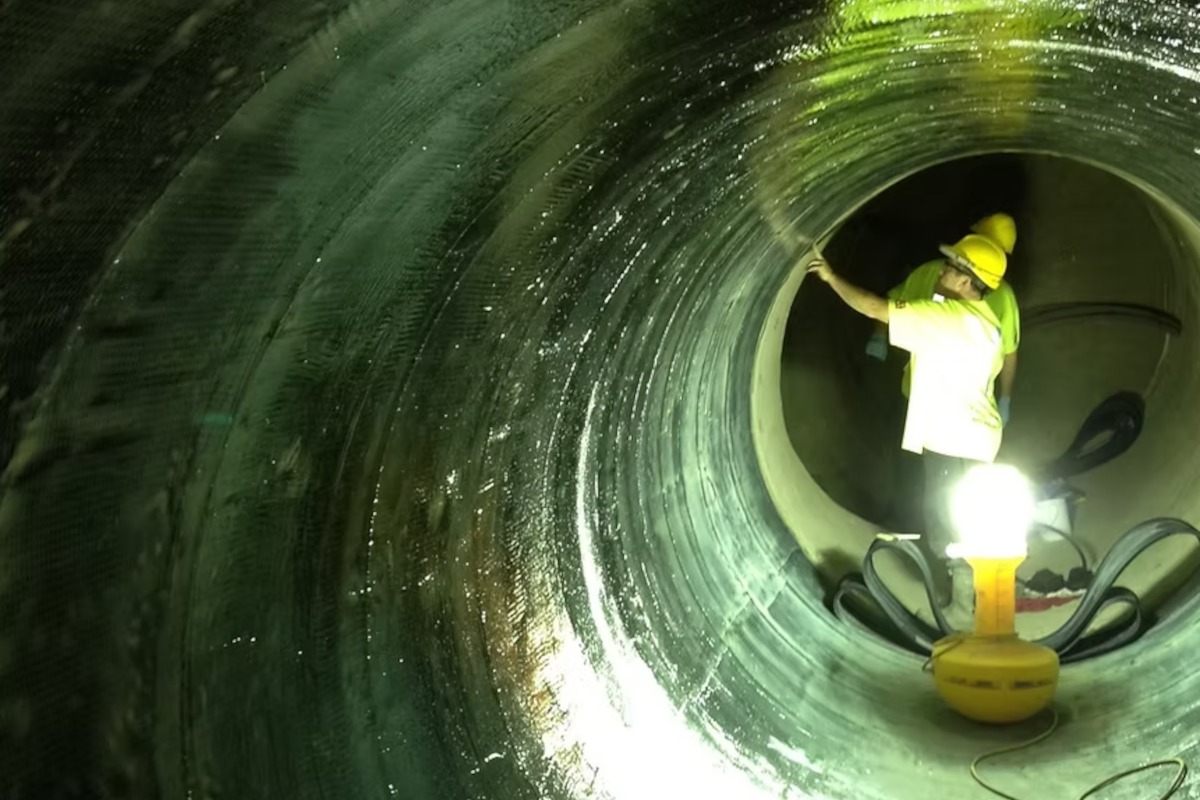Design-Build
 The Royal Canadian Yacht Club (RCYC) had a serious problem. Hydrant flow testing had determined that its water supply from the City of Toronto’s watermain system was insufficient to protect its historic Clubhouse on Toronto Island from a potential total loss due to fire. By summer 2008, the Club’s insurer demanded action and timing was tight to get the necessary approvals and implement a solution before the Clubhouse re-opened in May 2009.
The Royal Canadian Yacht Club (RCYC) had a serious problem. Hydrant flow testing had determined that its water supply from the City of Toronto’s watermain system was insufficient to protect its historic Clubhouse on Toronto Island from a potential total loss due to fire. By summer 2008, the Club’s insurer demanded action and timing was tight to get the necessary approvals and implement a solution before the Clubhouse re-opened in May 2009.
RCYC asked Underground Consulting Inc. (UCI) for a recommendation on the lowest cost solution that would meet the required timelines. The logistics were considerable. The only land connection was a narrow right of way on that the existing watermain had been laid. Construction along this corridor would have been difficult due to limited working space and wet sand conditions below lake level. It would have also blocked access to other contractors and RCYC staff who were trying to implement other extensive health and safety improvements to the Clubhouse in the same time period.
UCI recommended that an entirely new water service be constructed by horizontal directional drilling (HDD) from the main Toronto Island under a lagoon to RCYC’s South Island, and from there under another lagoon to the North Island on which the Clubhouse is located. The length of the drilling would be 535 m.
Assembling the Design-Build Team
It was also recommended that RCYC proceed on a design-build basis in order to develop the most cost-effective design and ensure the specialized drilling contractor would be committed to carry out the construction in the narrow winter window. This was a deviation from RCYC’s normal three-bid policy, but was considered appropriate in this case due to the nature of the project. Subsequently, Totten Sims Hubicki Associates Ltd. (now Aecom) was retained on a negotiated contract to carry out the detailed design and obtain regulatory approvals. Avertex Utility Solutions Inc. was brought on board to make recommendations on the HDD design for the lagoon crossings. Once the final design was resolved, Avertex provided firm pricing to complete the installation, which was within RCYC’s budget allocation for the project.
The design-build process resulted in HDD prices that were 36 percent less than the low bid received by the City of Toronto on a similar project completed three years earlier through the public tender process.
As the project was urgent to resolve a fire safety issue and in consideration that the HDD method involved no in-water construction at all, the Toronto Region Conservation Authority (TRCA) was able to fast track the approval allowing construction to start in February 2009.
Island Logistics
Construction on the Toronto Islands brings its own particular construction logistical problems. All labor, equipment and materials must be brought over on the City of Toronto ferries. The heaviest pieces must be loaded on the Toronto Airport ferry across the Western Gap. Contractors’ hours are limited by the ferry schedules.
Getting the necessary construction equipment onto the main Toronto Island is one thing. Accessing the RCYC property brings another set of problems. The RCYC North Island is accessible to pickups and vans, but a narrow, vintage concrete bridge limits the access to wider and heavier vehicles, like vac-trucks, which are essential to the HDD operation. Further, the bridge from North Island to South Island could not carry the weight of the drill rig so other access options had to be considered.
Avertex felt the best way to drill the project was to set up on South Island, drill south under the lagoon to the main Toronto Island and then turn around and drill north to North Island under the other lagoon. The options for getting the drill rig onto South island were to either walk it across the frozen lagoon or barge it in. After some test holes were made in the ice, it was felt that walking on the ice was a little too risky. However, that meant that barging in the drill rig would either involve breaking a substantial thickness of ice or waiting for it to melt. The schedule would not allow time for melting, so a backhoe was put on a hired barge and the barge “dug” its way through the ice to South Island from the open harbor.
Construction Challenges
Work started in the last week of February. The large metering chamber was installed first on the Main Toronto Island to take advantage of the frost in the ground, which allowed the heavy concrete sections to be readily transported over the frozen park grassed areas.
The next stage was the drilling of the new 200-mm watermain under the south lagoon. This was accomplished without any problems by Avertex utilizing a Vermeer D36X50 drill rig. The remaining ice cap over the lagoon allowed the drilling fluid feed line and the suction line for the vac-truck to be easily laid from the Main Island to the drilling setup on South Island. The technician with a Digi-Trak tracking device could also walk on the ice to monitor the drill head cutting 4.5 m below the bottom of the lagoon.
The project completely changed its complexion as the work moved to the North Island. Ground conditions under North Island were much more difficult than the South Island. The loose, wet sands resisted holding up long enough to pull a watermain pipe into the bored hole and the first two attempts had to be abandoned. For the third attempt, Avertex brought in a larger StS Mixers M750G mixer and utilized a high-tech polymer to stabilize the hole. The new pipe was pulled into place in one shot, without the normal pre-reaming. It was a tense time until the new pipe was fully pulled into place.
The drilling of the third line on the North Island to the Clubhouse proved just as challenging. There are very few records as to what has been built underground at RCYC over the last 100 years. None of the drawings showing existing watermains were in any way accurate. There are so many abandoned and current utilities there that you literally cannot dig anywhere without finding multiple pipes. This cost some time as the hired utility locator had to be brought back twice, and Avertex had to hand dig in multiple locations to find the existing watermain that serviced the Clubhouse.
The first drilling attempt ran into an old buried stone seawall under the north lawn. The second attempt tried an alignment under the line of trees directly north of the lawn bowling green. This alignment got past the stone wall but near the pool building, the drill ran into a concrete abutment for a bridge that used to span the waterway that once separated the North Island into two islands. Once this concrete was broken out, the drilling was completed successfully. The new watermain was connected to the existing watermain that serviced the Clubhouse directly in front of the north steps. The 200-HDPE watermain had then been installed continuously from the Main Toronto Island to the Clubhouse.
Two new hydrants were installed on the North Island to replace the 60-year-old ones. The existing City watermain was capped south of the RCYC entrance bridge. On examination of the old cast iron pipe, it was clear why flow rates had been so poor. The existing 150-mm pipe was heavily tuberculated.
This was a clear demonstration of how aging infrastructure can have serious impact on fire/life safety.
A Successful Conclusion
Despite the problems on the North Island, Avertex was able to complete the new watermain in late April 2009 in time for restoration to be completed for the Club’s ceremonial opening.
Fire flow testing was carried out on May 1, 2009, by RCYC’s insurer’s engineers. The testing confirmed that the new watermain delivered sufficient water to satisfy the sprinkler requirements.
The RCYC watermain project was a perfect example of where the design-build process can deliver a difficult project efficiently, economically and without the disputes inherent in the low-bid tender process.
Gary E. Benner, P. Eng., is president of Underground Consulting Inc., based in Toronto, Ontario, Canada.
![]()




